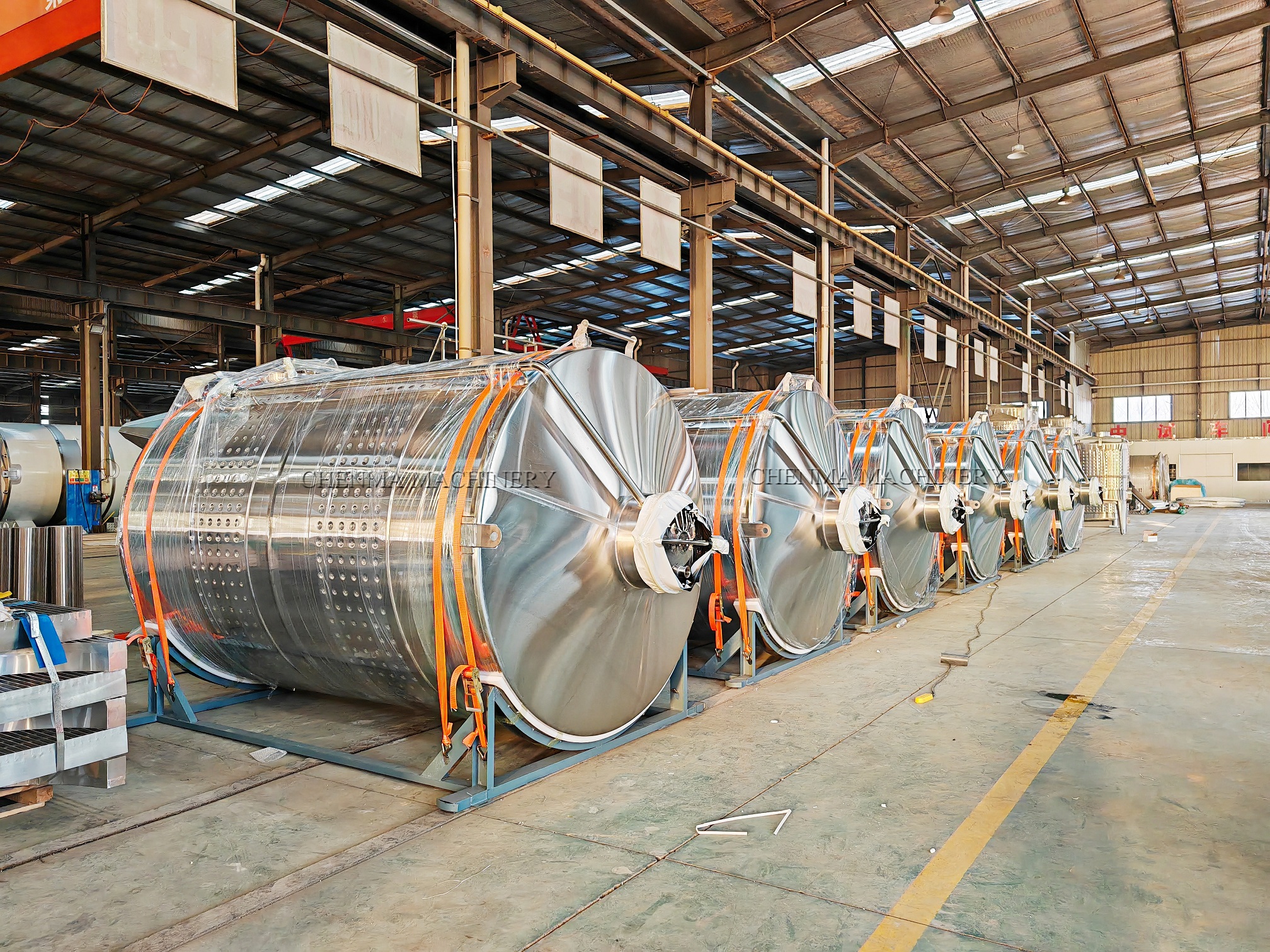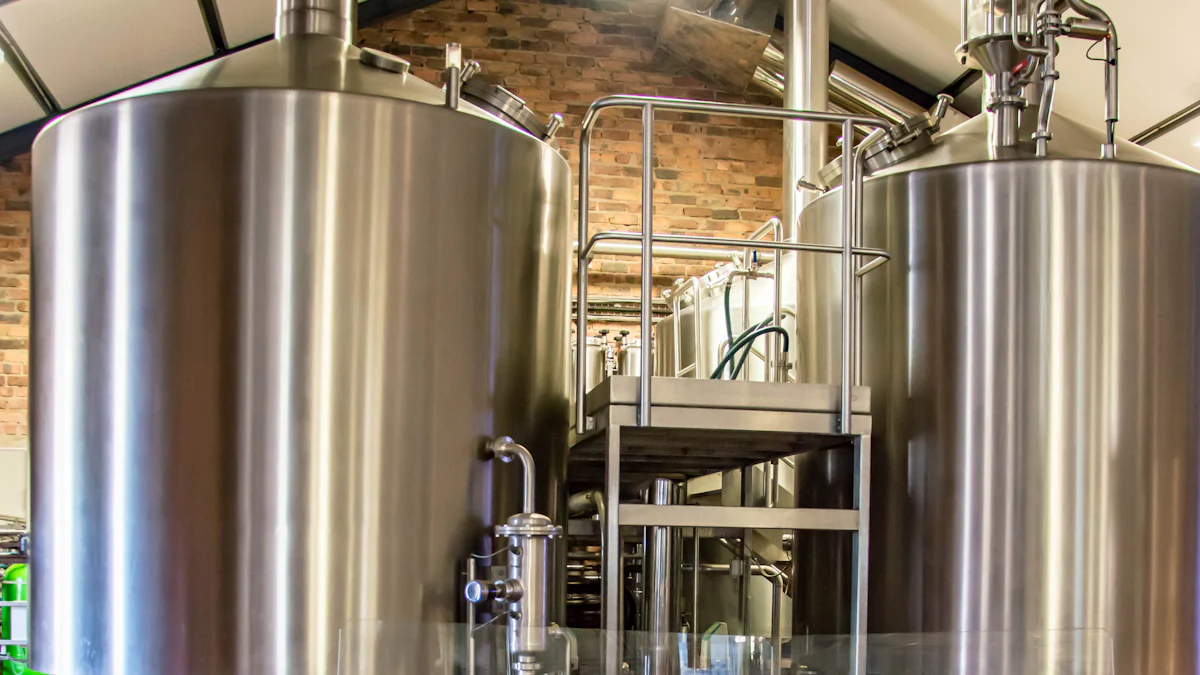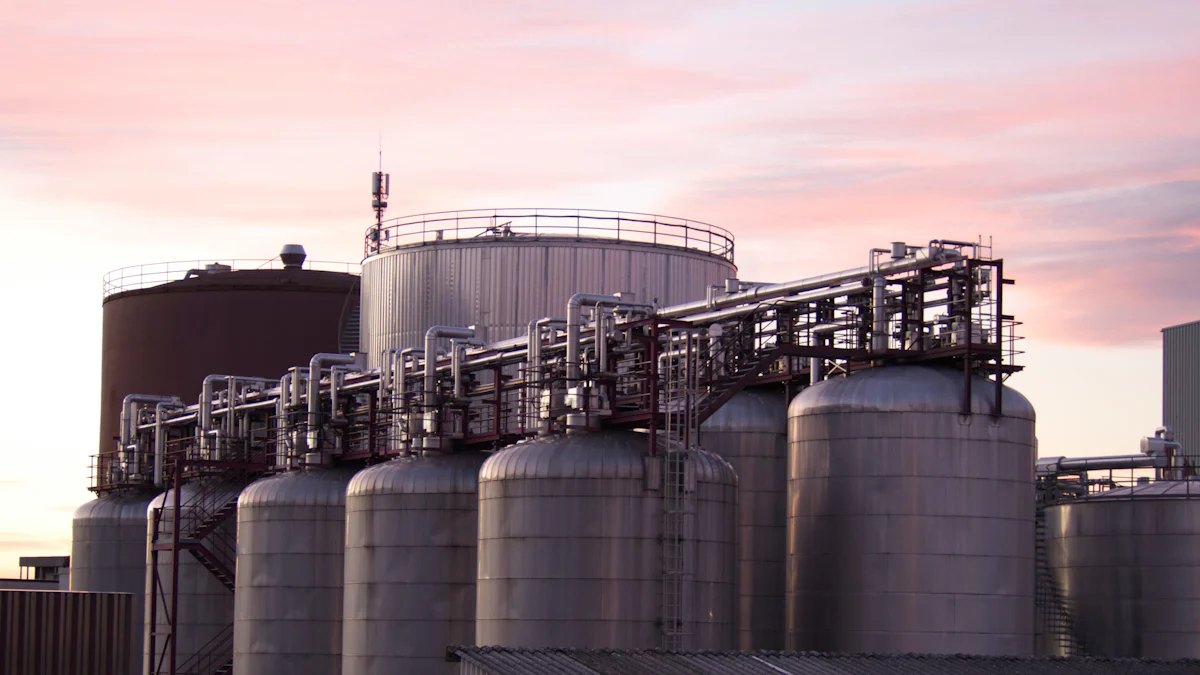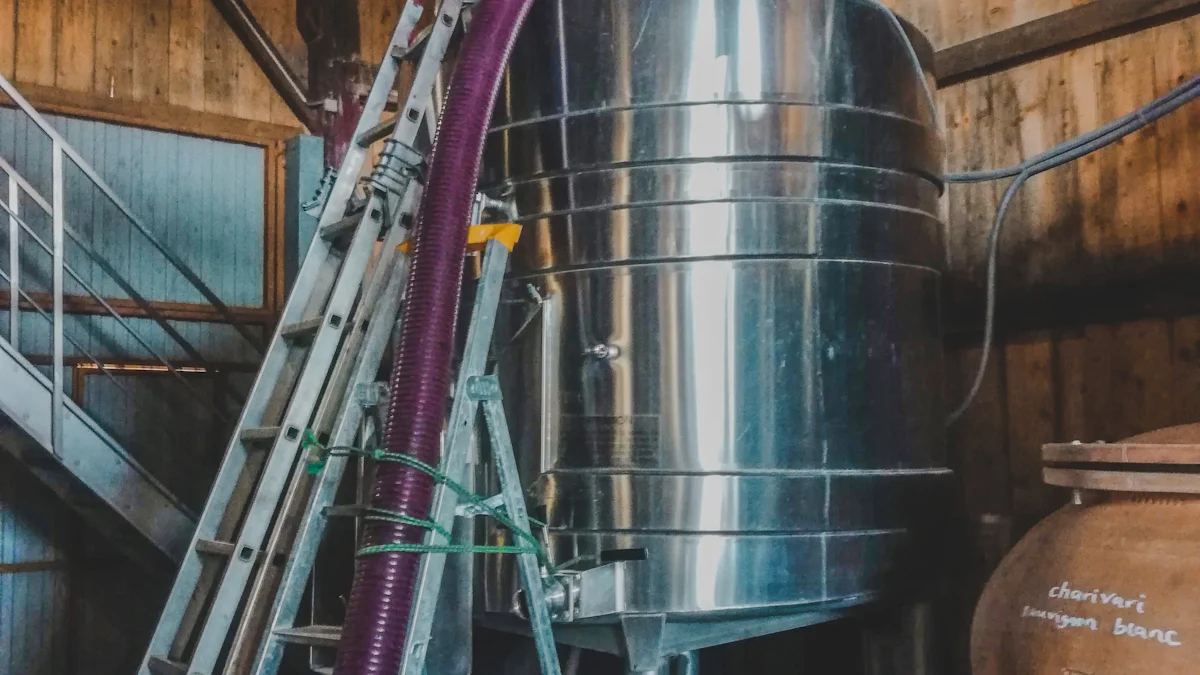
When it comes to crafting exceptional wine, the equipment you use plays a huge role. fermenting wine in stainless steel tanks have become a favorite for winemakers, and it’s easy to see why. These tanks offer precise temperature control, which is essential for managing fermentation. Their corrosion resistance and smooth surfaces make cleaning a breeze, ensuring your wine stays pure and free from unwanted flavors. Unlike wooden barrels, stainless steel doesn’t absorb odors or impart its own taste, allowing the true character of your grapes to shine.
Stainless steel tanks also create a controlled environment that supports consistent fermentation. With features like cooling jackets, you can fine-tune temperatures to enhance yeast activity and preserve the wine’s freshness. Plus, their durability and low maintenance costs make them a smart investment. By following a structured process, you can unlock the full potential of fermenting wine in stainless steel tanks and produce high-quality results every time.
Why Stainless Steel Tanks Are Ideal for Wine Fermentation
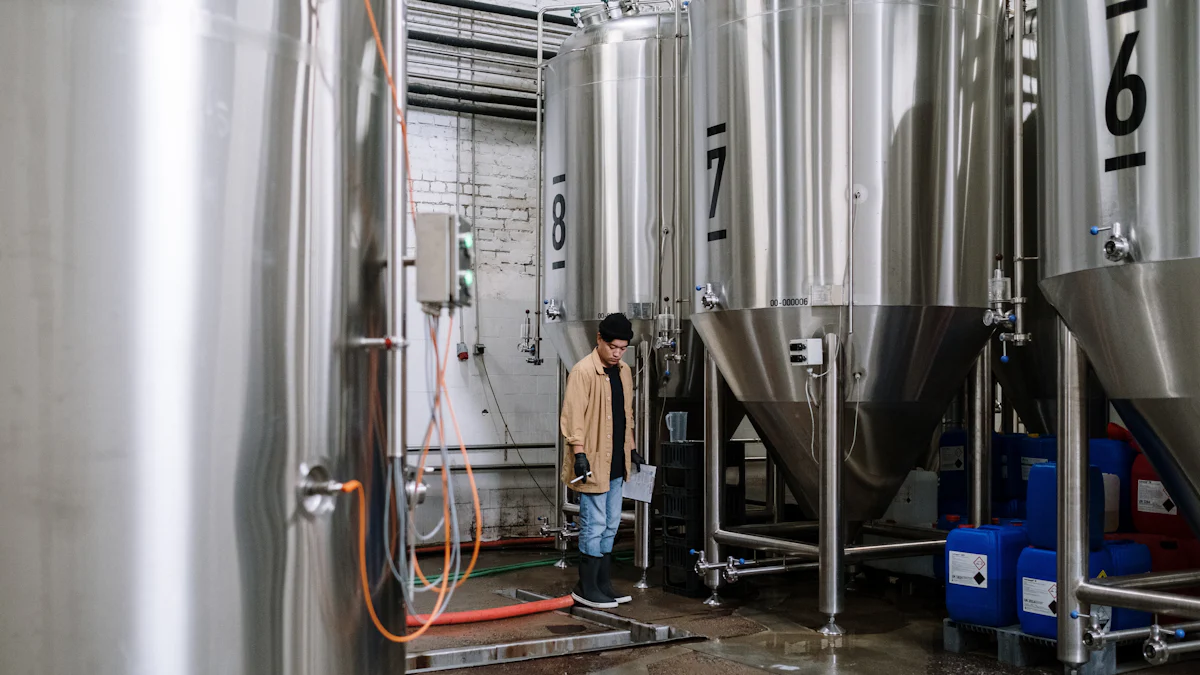
Key Features of Stainless Steel Tanks
Stainless steel tanks are packed with features that make them perfect for winemaking. Their corrosion resistance ensures they last for years without rusting or breaking down. This durability means you won’t have to worry about contaminants affecting your wine. The smooth, non-porous surface makes cleaning quick and easy, leaving no room for residue or bacteria to hide. Plus, these tanks are equipped with cooling systems that let you control fermentation temperatures with precision. This is crucial for maintaining the delicate balance of flavors in your wine.
Another standout feature is their strong antioxidant properties. Stainless steel prevents oxidation, which can ruin the taste and quality of your wine. These tanks can also handle high pressure during fermentation, keeping the process safe and reliable. On top of that, they’re environmentally friendly since they’re 100% recyclable. Here’s a quick breakdown of their key properties:
| Property | Description | |—————————–|——————————————————————————————————| | Corrosion Resistance | Stainless steel is resistant to corrosion, ensuring durability and longevity in fermentation processes. | | Ease of Cleaning | The smooth, non-porous surface allows for easy cleaning and reduces residue adhesion. | | Temperature Control | Equipped with cooling systems, stainless steel tanks maintain optimal fermentation temperatures. | | Strong Antioxidant Properties | Prevents oxidation, protecting the quality and flavor of the wine during fermentation. | | High-Pressure Resistance | Can withstand high pressures during fermentation, ensuring safety and reliability. | | Environmental Protection | 100% recyclable, reducing waste and environmental impact. |
Benefits for Preserving Wine Quality
When it comes to preserving the quality of your wine, stainless steel tanks truly shine. They create a neutral environment that doesn’t add any unwanted flavors. This allows the natural taste of your grapes to take center stage. Unlike wooden barrels, which can absorb odors or impart their own flavors, stainless steel keeps your wine pure.
These tanks also minimize oxygen exposure, which is vital for maintaining freshness and vibrant fruit flavors. With precise temperature control, you can prevent undesirable chemical reactions during fermentation. This ensures your wine develops the perfect balance of aromas and taste. The result? A consistent, high-quality product every time.
Versatility for Different Winemaking Needs
Stainless steel tanks are incredibly versatile, making them a favorite among winemakers. They’re suitable for fermenting wine in stainless steel tanks as well as other beverages like cider and beer. Their neutral environment allows you to experiment with various fermentation techniques without worrying about altering the wine’s flavor.
The tanks’ adaptability doesn’t stop there. They’re easy to clean and sanitize, ensuring proper hygiene for every batch. Whether you’re crafting a crisp white wine or a bold red, stainless steel tanks provide the stability and flexibility you need. They also support aging processes by minimizing oxygen exposure, helping you preserve the wine’s character and freshness.
Preparing Stainless Steel Tanks for Fermentation
Cleaning and Sanitizing the Tank
Before you start fermenting wine in stainless steel tanks, cleaning and sanitizing the tank is a must. A spotless tank ensures your wine remains free from contaminants and unwanted flavors. Follow these steps to get it right:
- Begin with a thorough cleaning. Remove any visible dirt or residue from the tank.
- Use a sanitizer recommended by the manufacturer. Dilute it properly and apply it evenly across the tank’s surface.
- Test the sanitizer’s effectiveness with test strips or surface contact tests. This ensures it’s doing its job.
- Rinse the tank thoroughly with hot water to remove any leftover sanitizer or contaminants.
- Dry the tank completely before adding your must. Moisture can lead to bacterial growth, so don’t skip this step.
A clean and sanitized tank sets the stage for a successful fermentation process. It’s worth the extra effort to ensure your wine develops its best flavors.
Inspecting the Tank for Damage or Residue
Once your tank is clean, inspect it carefully. Even minor damage or residue can affect the quality of your wine. Here’s how you can check your tank like a pro:
- Use a light source to visually examine the tank’s interior.
- For hard-to-see areas, mirrors or magnification tools can help.
- If your tank has an access manway, physically enter the tank to inspect its inner surfaces.
- Pay attention to the distance and angle of your light source for a detailed view.
These tools and techniques ensure your tank is in top condition. Regular inspections prevent surprises during fermentation and keep your wine safe.
Setting Up the Tank for Fermentation
Now that your tank is clean and damage-free, it’s time to set it up for fermentation. Start by ensuring all fittings and valves are securely attached. Removable fittings are ideal since they’re easier to clean and maintain. Check that the cooling system is functioning properly. Temperature control is crucial for managing fermentation and preserving the wine’s quality.
Next, prepare the tank’s interior. Stainless steel tanks often have smooth surfaces and rounded corners, which make cleaning and setup easier. If your tank has a sample valve, test it to ensure it’s working. This will help you monitor the fermentation process later.
Finally, position the tank in a stable, temperature-controlled environment. This ensures consistent fermentation and protects your wine from external factors. With your tank ready, you’re all set to begin the exciting process of winemaking.
Step-by-Step Guide to Fermenting Wine in Stainless Steel Tanks
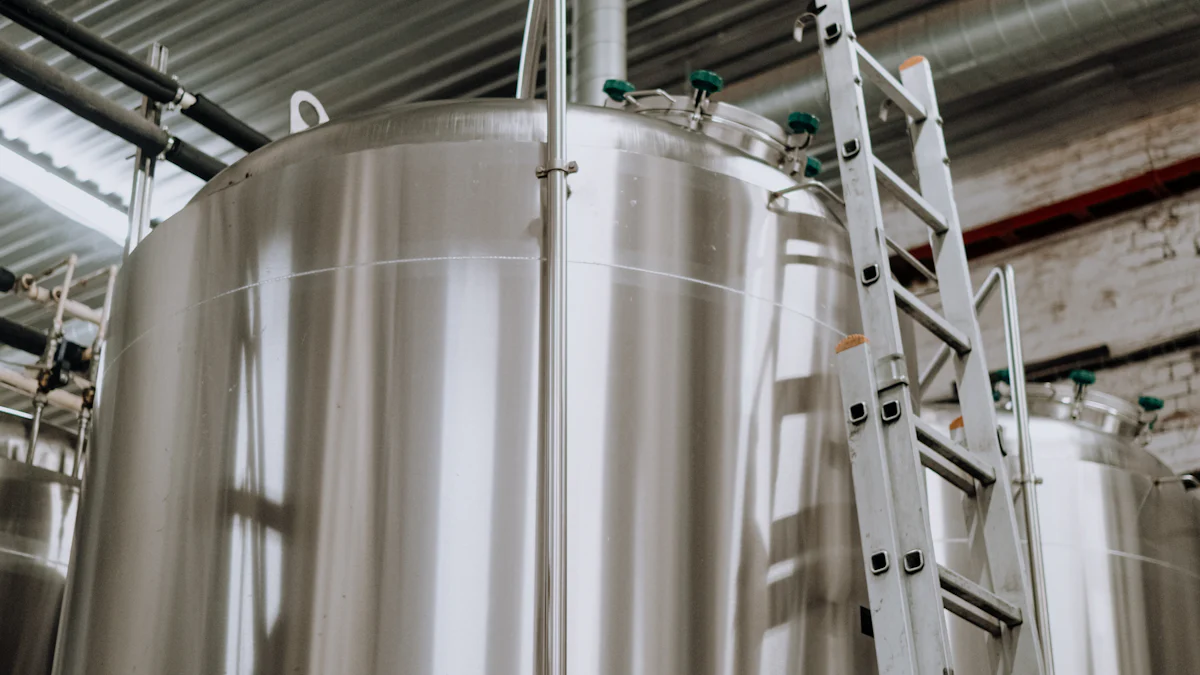
Preparing the Must
Before you begin fermenting wine in stainless steel tanks, you need to prepare the must properly. This step lays the foundation for a successful fermentation process. Follow these essential steps:
- Monitor the temperature: Keep the must within the ideal range of 18-22°C. This ensures the yeast can thrive and ferment effectively.
- Prevent oxidation: Seal the tank tightly to keep air out. Oxygen exposure can spoil the flavor and lead to bacterial contamination.
- Stir gently: Occasionally stir the must to help the yeast interact with the sugar. Avoid over-stirring to prevent oxidation.
- Discharge sediment: Once fermentation is complete, remove sediment from the bottom of the tank. This keeps your wine clear and flavorful.
- Clean and disinfect: After each use, clean the tank thoroughly with a stainless steel-safe detergent. Disinfect all parts that come into contact with the must.
By following these steps, you’ll create the perfect environment for your wine to develop its best flavors.
Filling the Tank
When filling your stainless steel tank with must, there are a few key considerations to keep in mind:
- Control the temperature: Ensure the must is at the right temperature (18-22°C) before filling the tank.
- Check the tank’s design: A conical bottom makes it easier to discharge sediment later. Smooth surfaces prevent residue buildup.
- Seal the tank properly: A good seal prevents air from entering, which could lead to oxidation and spoilage.
- Use sampling ports: These allow you to monitor the wine’s progress without opening the tank.
Taking these precautions ensures a smooth start to the fermentation process and helps maintain the wine’s quality.
Initiating Fermentation
Once the tank is filled, it’s time to kick off fermentation. Here are the indicators of a successful start:
| Indicator | Description | |——————————-|————————————————————————————————–| | Temperature Control | Maintain the ideal range (18-22°C) to activate yeast and encourage fermentation. | | Prevention of Oxidation | Ensure the tank is sealed to keep air out and preserve the wine’s flavor. | | Monitoring Sediment Discharge | Check for sediment buildup and plan for timely removal after fermentation. |
Keep an eye on these factors as fermentation begins. Proper temperature control and sealing are critical for achieving the best results. With these steps, you’re well on your way to crafting exceptional wine.
Managing the Fermentation Process
Once fermentation begins, your job is to guide it to success. This stage is where the magic happens, and keeping a close eye on the process ensures your wine develops the right flavors and aromas. Here’s how you can manage fermentation like a pro:
- Monitor the temperature daily. Yeast thrives within a specific range, usually 18-22°C. Use the tank’s cooling system to maintain this range. If the temperature gets too high, the yeast might produce off-flavors. Too low, and fermentation could stall.
- Check the sugar levels regularly. Use a hydrometer or refractometer to measure the sugar content. As fermentation progresses, the sugar levels will drop. This helps you track how far along the process is.
- Stir the must gently. Stirring helps distribute the yeast evenly and prevents sediment from settling too quickly. Avoid over-stirring, as it can introduce oxygen, which might spoil the wine.
- Watch for signs of fermentation activity. Look for bubbling or foaming, which indicates that the yeast is converting sugar into alcohol and carbon dioxide. If activity slows down too early, you may need to troubleshoot.
Pro Tip: Use the tank’s sample valve to draw small amounts of wine for testing. This lets you monitor progress without exposing the entire batch to air.
By staying attentive and making small adjustments, you’ll keep the fermentation process on track and set the stage for a great final product.
Completing Fermentation
As fermentation nears its end, you’ll notice the bubbling slows down, and the sugar levels stabilize. This signals that the yeast has consumed most of the sugar. Here’s what you need to do to wrap things up:
- Confirm fermentation is complete. Use your hydrometer to check the specific gravity. A reading of 0.990 to 1.000 usually means fermentation is done.
- Remove sediment promptly. Sediment, or lees, can affect the wine’s flavor if left too long. Use the tank’s conical bottom to discharge it easily.
- Taste the wine. Sampling at this stage helps you assess the flavor profile. If it’s too sharp, you might consider secondary fermentation or aging to mellow it out.
- Cool the wine. Lowering the temperature halts any remaining yeast activity. This step stabilizes the wine and prepares it for the next phase, whether that’s aging or bottling.
Note: If you’re fermenting wine in stainless steel tanks, their precise temperature control and easy sediment removal make this stage much simpler.
Completing fermentation is a satisfying milestone. With careful attention, you’ll have a wine that’s ready for the next steps in its journey.
Post-Fermentation Steps for Stainless Steel Tanks
Cleaning and Sanitizing After Use
Once fermentation is complete, cleaning and sanitizing your stainless steel tank is essential. This step ensures your equipment stays in top condition and prevents contamination in future batches. Start by draining any remaining liquid and removing sediment. Use a stainless steel-safe detergent to scrub the interior thoroughly. Pay extra attention to corners and fittings where residue might hide.
After cleaning, apply a food-grade sanitizer to eliminate any lingering bacteria or yeast. Follow the manufacturer’s instructions for dilution and contact time. Rinse the tank with hot water to remove any sanitizer residue, then let it air dry completely. Moisture can encourage bacterial growth, so ensure the tank is fully dry before storing it. Regular cleaning and sanitizing keep your tank ready for the next round of winemaking.
Deciding Between Stainless Steel or Barrel Aging
After fermentation, you’ll need to decide whether to age your wine in stainless steel or oak barrels. Each option offers unique benefits, so consider your goals carefully.
- Stainless steel provides a neutral environment, preserving the wine’s natural flavors without adding external notes.
- Oak barrels, on the other hand, introduce additional flavors like vanilla or spice and enhance the wine’s tannin structure.
Think about your flavor preferences and the style you want to achieve. For example, if you’re crafting a crisp white wine, stainless steel might be the better choice. If you’re aiming for a bold red with complex layers, barrel aging could be ideal. Cost is another factor. Stainless steel tanks are reusable and require less maintenance, while barrels need regular replacement. Your decision should align with your wine’s varietal descriptors and your desired outcome.
Proper Storage Conditions for Wine
Storing wine properly after fermentation is crucial for preserving its quality. Stainless steel tanks excel in this area, thanks to their consistent temperature control. Use tanks with dimple jackets or efficient cooling systems to maintain the ideal storage temperature, typically between 50-60°F. This helps stabilize the wine and prevents spoilage.
Stainless steel’s high corrosion resistance also protects your wine from contamination. Ensure the tank is sealed tightly to minimize oxygen exposure, which can alter the wine’s flavor. Regularly monitor the temperature and humidity levels in your storage area to maintain optimal conditions. By following these steps, you’ll keep your wine fresh and ready for bottling or further aging.
Tips for Optimizing the Fermentation Process
Using Cooling Jackets and Sample Valves
Cooling jackets and sample valves are game-changers when it comes to fermenting wine in stainless steel tanks. They make the process smoother and more efficient. Here’s how they help:
- Cooling jackets regulate the temperature by circulating cooling water around the tank. This keeps the fermentation process steady and prevents overheating, which can harm the yeast.
- Sample valves let you take small samples of wine without opening the tank. This means you can monitor the progress without exposing the wine to air.
- Together with temperature control systems, these features ensure the yeast ferments at the right temperature, enhancing the wine’s flavor and aroma.
By using these tools, you’ll have better control over the fermentation process and produce consistently high-quality wine.
Managing Oxygen Exposure
Oxygen can be both a friend and a foe during fermentation. Managing its exposure is key to preserving your wine’s quality. Here are some best practices:
- Use inert gases like nitrogen or carbon dioxide to shield the wine from oxygen.
- Keep the tank as full as possible to reduce the surface area exposed to air.
- For white wines, closed-top tanks are ideal since they limit oxygen exposure.
While too much oxygen can cause oxidation and off flavors, a small amount is necessary for healthy yeast activity. Striking the right balance ensures your wine develops beautifully without any unpleasant odors.
Regular Monitoring and Adjustments
Fermentation isn’t a “set it and forget it” process. Regular monitoring helps you catch issues early and make adjustments as needed. Here’s what to focus on:
- Temperature checks: Use the tank’s cooling system to maintain the ideal range for your wine.
- Sugar levels: Measure the sugar content daily with a hydrometer or refractometer. This shows how far along the fermentation is.
- Visual cues: Look for bubbling or foaming, which indicates active fermentation. If activity slows too soon, you may need to troubleshoot.
By staying proactive, you’ll ensure the fermentation process stays on track and delivers the best results.
Common Mistakes to Avoid When Fermenting Wine in Stainless Steel Tanks
Neglecting Cleaning and Sanitization
Skipping proper cleaning and sanitization is one of the biggest mistakes you can make. Even a small amount of leftover residue or bacteria can spoil your wine. Before starting, always clean the tank thoroughly with a stainless steel-safe detergent. Pay close attention to corners, fittings, and valves where residue tends to hide. After cleaning, sanitize the tank using a food-grade sanitizer. This step kills any lingering bacteria or yeast that could interfere with fermentation.
Don’t forget to test the sanitizer’s effectiveness. Use test strips or surface contact tests to ensure the tank is ready. Once sanitized, rinse the tank with hot water and let it dry completely. Moisture can encourage bacterial growth, so drying is just as important as cleaning. Neglecting these steps can lead to off-flavors, contamination, or even a ruined batch of wine.
Overlooking Temperature Control
Temperature control is critical when fermenting wine in stainless steel tanks. Yeast thrives within a specific range, usually 18-22°C. If the temperature gets too high, the yeast might produce off-flavors or stop working altogether. Too low, and fermentation could stall.
To avoid these issues, use tanks with built-in cooling jackets or coils. These systems help regulate the temperature and prevent fluctuations. Insulated tanks can also provide extra stability. Regularly monitor the temperature with a thermometer or digital sensor. Staying on top of this ensures your wine ferments smoothly and develops the right flavors.
Allowing Excessive Oxygen Exposure
Oxygen exposure can ruin your wine. Too much oxygen can cause oxidation, leading to unpleasant changes in aroma, color, and taste. For example, oxidation can decompose tannins and anthocyanins, turning your wine yellow. It can also increase volatile acidity, resulting in a sour or vinegary flavor.
To prevent this, always seal your tank tightly. Use inert gases like nitrogen or carbon dioxide to create a protective layer over the wine. Keep the tank as full as possible to minimize the surface area exposed to air. These steps help preserve the wine’s quality and ensure it tastes as intended.
Pro Tip: Closed-top tanks are ideal for white wines since they limit oxygen exposure more effectively.
Rushing the Fermentation Process
When it comes to fermenting wine, patience isn’t just a virtue—it’s a necessity. Rushing the fermentation process can lead to a host of problems that affect the quality of your wine. You might feel tempted to speed things up, especially if you’re eager to see the final product. But trust me, taking shortcuts here can ruin all your hard work.
Fermentation is a delicate process. Yeast needs time to convert sugars into alcohol and develop the wine’s flavors. If you try to rush it by increasing the temperature or adding too much yeast, you risk creating off-flavors. High temperatures can cause the yeast to produce unwanted byproducts like fusel alcohols, which give the wine a harsh taste. Over-pitching yeast can lead to an overly aggressive fermentation, stripping the wine of its subtle aromas.
Tip: Keep the fermentation temperature steady, ideally between 18-22°C. Use the cooling system in your stainless steel tank to maintain this range.
Another common mistake is bottling the wine too soon. If fermentation hasn’t fully completed, residual sugars can cause secondary fermentation in the bottle. This can lead to unwanted carbonation or even exploding bottles. Nobody wants that mess!
Here’s how you can avoid rushing:
- Monitor sugar levels daily. Use a hydrometer to check when the specific gravity stabilizes, indicating fermentation is complete.
- Taste the wine. Sampling helps you understand how the flavors are developing. If it tastes too sharp or unbalanced, give it more time.
- Plan ahead. Winemaking is a slow process. Build extra time into your schedule so you’re not tempted to cut corners.
Remember: Good wine takes time. Let the yeast do its job at its own pace. Your patience will pay off with a wine that’s rich, balanced, and full of character.
How Chenma Machinery Supports Effective Wine Fermentation
Customizable Stainless Steel Tanks for Winemaking
Chenma Machinery understands that every winemaker has unique needs. That’s why their stainless steel tanks are fully customizable. Whether you’re crafting a crisp white or a bold red, these tanks can be tailored to match your specific goals. They offer precise temperature control, which is essential for maintaining the delicate balance of flavors during fermentation. Their non-reactive surfaces preserve the purity of your wine, ensuring no unwanted flavors interfere with the natural character of your grapes.
These tanks also minimize bacterial growth, thanks to their smooth, easy-to-clean surfaces. You’ll appreciate how they preserve freshness and vibrant aromatics, creating an airtight environment that protects your wine. Plus, their versatility allows you to experiment with different winemaking techniques without compromising quality. With Chenma’s tanks, you get a cost-effective solution that’s built to last.
Advanced Features for Temperature and Oxygen Control
Chenma Machinery’s tanks come equipped with advanced features that make fermenting wine in stainless steel tanks a breeze. The floating lid design reduces headspace, minimizing the risk of oxidation during fermentation. This is crucial for preserving the wine’s flavor and aroma. Dimple cooling jackets provide efficient temperature control, helping you maintain the ideal fermentation range.
You’ll also find cutting-edge technology like RTD probes and bi-metallic thermometers for precise temperature monitoring. Need even more control? These tanks include gas-tight seals and systems for inert gas flushing, which further reduce oxygen exposure. With these features, you can confidently manage both temperature and oxygen levels, ensuring your wine develops beautifully.
Turnkey Solutions for Winemaking Equipment and Training
Chenma Machinery doesn’t just stop at manufacturing tanks. They offer complete turnkey solutions to support your winemaking journey. From process design to equipment manufacturing, they’ve got you covered. Their team handles installation and commissioning, so you can start using your equipment right away.
What’s more, they provide technical training to help you get the most out of your tanks. Whether you’re new to winemaking or a seasoned pro, their expertise ensures you’re set up for success. With Chenma’s comprehensive support, you’ll have everything you need to produce exceptional wine.
Fermenting wine in stainless steel tanks offers unmatched benefits. These tanks preserve freshness, maintain vibrant flavors, and allow the true character of your grapes to shine. Their smooth surfaces make cleaning simple, reducing contamination risks. Plus, they’re cost-effective and versatile, letting you experiment with different winemaking techniques.
To achieve the best results, follow essential steps like maintaining accurate temperature control, sealing the tank to prevent oxidation, and discharging sediment promptly. Regular cleaning and gentle stirring also ensure your wine develops beautifully.
Ready to elevate your winemaking? Chenma Machinery provides customizable stainless steel tanks with advanced features to simplify your process. With their support, you’ll craft exceptional wine every time.
FAQ
What makes stainless steel tanks better than oak barrels for fermentation?
Stainless steel tanks don’t add flavors to your wine, letting the grape’s natural character shine. They’re easier to clean, last longer, and offer precise temperature control. Oak barrels, while great for adding complexity, require more maintenance and can’t match the consistency of stainless steel.
How do I prevent oxidation during fermentation?
Seal your tank tightly and use inert gases like nitrogen to create a protective layer over the wine. Keep the tank full to reduce air exposure. For white wines, closed-top tanks work best to limit oxygen contact and preserve freshness.
Can I ferment both red and white wines in the same tank?
Absolutely! Stainless steel tanks are versatile and neutral, making them perfect for both red and white wines. Just clean and sanitize thoroughly between batches to avoid cross-contamination. Their temperature control features also adapt to the needs of different wine types.
How often should I monitor the fermentation process?
Check daily. Monitor temperature, sugar levels, and fermentation activity like bubbling or foaming. Use tools like hydrometers and sample valves to track progress without exposing the wine to air. Regular checks help you catch issues early and make adjustments.
Do stainless steel tanks require special maintenance?
Not really! Clean them with a stainless steel-safe detergent after each use. Sanitize thoroughly to prevent contamination. Inspect for damage or residue regularly. Their smooth, non-porous surfaces make maintenance simple and quick, saving you time and effort.

